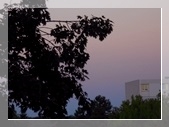
A fine show during the evening or morning twilight consists into seeing the night climbing -or descending- in the sky on the opposite side of where the Sun sets -or rises. As far as the show in the evening twilight is concerned -as the description is inverted for when it is seen by dawn- you will see, East, as the Sun is getting into the twilight, a band climbing in the sky and getting dark! You are just seeing indeed how the night is rising at the opposite of the Sun. Such a phenomenon is merely the Earth's shadow as, with the Sun descending on the horizon -and then under it- it projects the Earth's shadow unto the atmosphere of it. That band is dark blue, or greyish-blue in color. Should you have a plain horizon at your disposal from where you observe, you will be able to check that, azimutally, the band of the Earth's shadow is stretching along 180 degrees as the more the observer is in altitude, the more the frontier of the dark segment is neat. With the dark segment, which is immediately contiguous to the horizon, comes above the 'anti-twilight arch' or the 'Belt of Venus', or the 'Venus' Girdle'. That additional band, which is 10 to 20 degrees in height, has a pink and orange color. Both the Belt of Venus and the dark segment are not neatly separated but their borders are fading into each other instead. The anti-twilight arch is also observed during a total solar eclipse. As the dark segment is the shadow of Earth projected unto its own atmosphere, the Belt of Venus is that fraction of the high atmosphere as illuminated by Sun. Its color is due to that sunlight is journeying across a important fraction of the Earth's atmosphere, which only let the red component through. More technically yet, the sunlight comes to illuminate particules in the lower atmosphere as those are refracting -or backscattering- it in direction of the upper atmosphere. The Belt of Venus theoretically fade when the Sun passes under the horizon. On a other hand, the more the Sun is descending into its twilight, the less the border between the dark segment and the anti-twilight arch is seen because the illuminated part of the upper atmosphere is getting thinner. The night eventually wins over as the Earth's shadow and the Belt of Venus are blending into it
 | The dark segment and the anti-twilight arch as seen on the eastern horizon!. picture site 'Amateur Astronomy' |
Let's also mention that, on the Sun's side -which is also true for sunrise- you may also seen what is called the 'golden hour,' as the sky is getting a dark blue hue. This is twilight (for a more astronomical view of it, check with data at page Twilight, Sun, Moon'). Such a time is famed for when flowers' scent is at its best as by dawn it is when the whole of birds is singing. How long such a moment is lasting depends upon the observer's latitude. The more the latitude, the more the twilight is lasting! The Golden hour is considered especially prized by photographers and film directors because the color temperature is about 3,500 K instead of 5,500 K during midday. As sunlight moreover is journeying a longer distance into the atmosphere makes that the illumination of a scenery comes less from direct ligth than through indirect one as provided by the whole sky. As such a journey also is refracting more blue light, that also brings a redder light. Shadows at last are longer and less dark, or even absent (when the Sun is under the horizon). The sky's blue color which gets more intense the farther from the horizon one looks is due to that sunlight there is just refracted by the air's molecules, or the Rayleigh diffusion
Website Manager: G. Guichard, site 'Amateur Astronomy,' http://stars5.6te.net. Page Editor: G. Guichard. last edited: 4/23/2013. contact us at ggwebsites@outlook.com